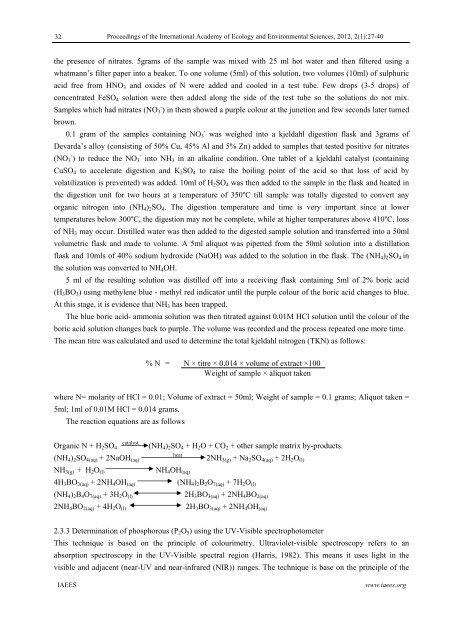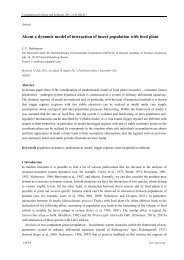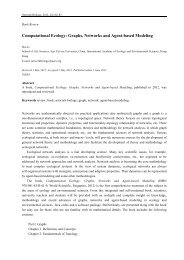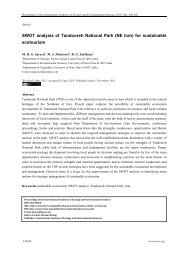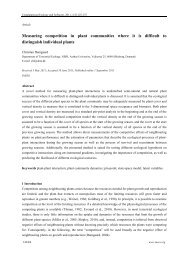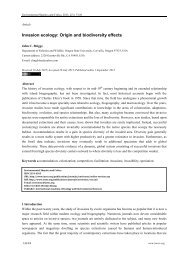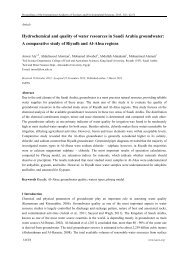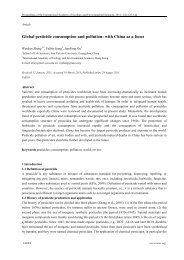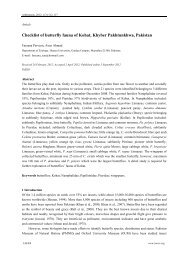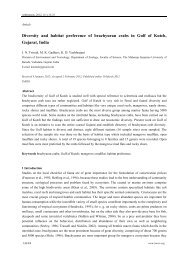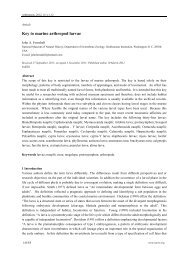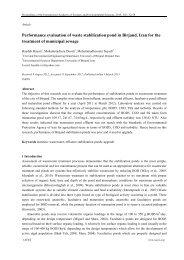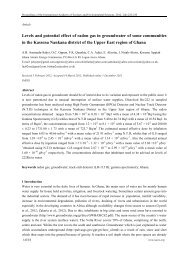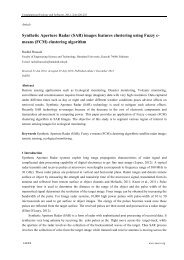Quality control analysis of imported fertilizers used in Ghana: the ...
Quality control analysis of imported fertilizers used in Ghana: the ...
Quality control analysis of imported fertilizers used in Ghana: the ...
Create successful ePaper yourself
Turn your PDF publications into a flip-book with our unique Google optimized e-Paper software.
32<br />
Proceed<strong>in</strong>gs <strong>of</strong> <strong>the</strong> International Academy <strong>of</strong> Ecology and Environmental Sciences, 2012, 2(1):27-40<br />
<strong>the</strong> presence <strong>of</strong> nitrates. 5grams <strong>of</strong> <strong>the</strong> sample was mixed with 25 ml hot water and <strong>the</strong>n filtered us<strong>in</strong>g a<br />
whatmann’s filter paper <strong>in</strong>to a beaker. To one volume (5ml) <strong>of</strong> this solution, two volumes (10ml) <strong>of</strong> sulphuric<br />
acid free from HNO 3 and oxides <strong>of</strong> N were added and cooled <strong>in</strong> a test tube. Few drops (3-5 drops) <strong>of</strong><br />
concentrated FeSO 4 solution were <strong>the</strong>n added along <strong>the</strong> side <strong>of</strong> <strong>the</strong> test tube so <strong>the</strong> solutions do not mix.<br />
Samples which had nitrates (NO - 3 ) <strong>in</strong> <strong>the</strong>m showed a purple colour at <strong>the</strong> junction and few seconds later turned<br />
brown.<br />
-<br />
0.1 gram <strong>of</strong> <strong>the</strong> samples conta<strong>in</strong><strong>in</strong>g NO 3 was weighed <strong>in</strong>to a kjeldahl digestion flask and 3grams <strong>of</strong><br />
Devarda’s alloy (consist<strong>in</strong>g <strong>of</strong> 50% Cu, 45% Al and 5% Zn) added to samples that tested positive for nitrates<br />
(NO - 3 ) to reduce <strong>the</strong> NO - 3 <strong>in</strong>to NH 3 <strong>in</strong> an alkal<strong>in</strong>e condition. One tablet <strong>of</strong> a kjeldahl catalyst (conta<strong>in</strong><strong>in</strong>g<br />
CuSO 4 to accelerate digestion and K 2 SO 4 to raise <strong>the</strong> boil<strong>in</strong>g po<strong>in</strong>t <strong>of</strong> <strong>the</strong> acid so that loss <strong>of</strong> acid by<br />
volatilization is prevented) was added. 10ml <strong>of</strong> H 2 SO 4 was <strong>the</strong>n added to <strong>the</strong> sample <strong>in</strong> <strong>the</strong> flask and heated <strong>in</strong><br />
<strong>the</strong> digestion unit for two hours at a temperature <strong>of</strong> 350°C till sample was totally digested to convert any<br />
organic nitrogen <strong>in</strong>to (NH 4 ) 2 SO 4 . The digestion temperature and time is very important s<strong>in</strong>ce at lower<br />
temperatures below 300°C, <strong>the</strong> digestion may not be complete, while at higher temperatures above 410°C, loss<br />
<strong>of</strong> NH 3 may occur. Distilled water was <strong>the</strong>n added to <strong>the</strong> digested sample solution and transferred <strong>in</strong>to a 50ml<br />
volumetric flask and made to volume. A 5ml aliquot was pipetted from <strong>the</strong> 50ml solution <strong>in</strong>to a distillation<br />
flask and 10mls <strong>of</strong> 40% sodium hydroxide (NaOH) was added to <strong>the</strong> solution <strong>in</strong> <strong>the</strong> flask. The (NH 4 ) 2 SO 4 <strong>in</strong><br />
<strong>the</strong> solution was converted to NH 4 OH.<br />
5 ml <strong>of</strong> <strong>the</strong> result<strong>in</strong>g solution was distilled <strong>of</strong>f <strong>in</strong>to a receiv<strong>in</strong>g flask conta<strong>in</strong><strong>in</strong>g 5ml <strong>of</strong> 2% boric acid<br />
(H 3 BO 3 ) us<strong>in</strong>g methylene blue - methyl red <strong>in</strong>dicator until <strong>the</strong> purple colour <strong>of</strong> <strong>the</strong> boric acid changes to blue.<br />
At this stage, it is evidence that NH 3 has been trapped.<br />
The blue boric acid- ammonia solution was <strong>the</strong>n titrated aga<strong>in</strong>st 0.01M HCl solution until <strong>the</strong> colour <strong>of</strong> <strong>the</strong><br />
boric acid solution changes back to purple. The volume was recorded and <strong>the</strong> process repeated one more time.<br />
The mean titre was calculated and <strong>used</strong> to determ<strong>in</strong>e <strong>the</strong> total kjeldahl nitrogen (TKN) as follows:<br />
% N = N × titre × 0.014 × volume <strong>of</strong> extract ×100<br />
Weight <strong>of</strong> sample × aliquot taken<br />
where N= molarity <strong>of</strong> HCl = 0.01; Volume <strong>of</strong> extract = 50ml; Weight <strong>of</strong> sample = 0.1 grams; Aliquot taken =<br />
5ml; 1ml <strong>of</strong> 0.01M HCl = 0.014 grams.<br />
The reaction equations are as follows<br />
catalyst<br />
Organic N + H 2 SO 4<br />
(NH 4 ) 2 SO 4(aq) + 2NaOH (aq)<br />
NH 3(g) + H 2 O (l)<br />
4H 3 BO 3(aq) + 2NH 4 OH (aq)<br />
(NH 4 ) 2 B 4 O 7(aq) + 3H 2 O (l)<br />
2NH 4 BO 2(aq) + 4H 2 O (l)<br />
(NH 4 ) 2 SO 4 + H 2 O + CO 2 + o<strong>the</strong>r sample matrix by-products.<br />
heat<br />
2NH 3(g) + Na 2 SO 4(aq) + 2H 2 O (l)<br />
NH 4 OH (aq)<br />
(NH 4 ) 2 B 2 O 7(aq) + 7H 2 O (l)<br />
2H 3 BO 3(aq) + 2NH 4 BO 2(aq)<br />
2H 3 BO 3(aq) + 2NH 4 OH (aq)<br />
2.3.3 Determ<strong>in</strong>ation <strong>of</strong> phosphorous (P 2 O 5 ) us<strong>in</strong>g <strong>the</strong> UV-Visible spectrophotometer<br />
This technique is based on <strong>the</strong> pr<strong>in</strong>ciple <strong>of</strong> colourimetry. Ultraviolet-visible spectroscopy refers to an<br />
absorption spectroscopy <strong>in</strong> <strong>the</strong> UV-Visible spectral region (Harris, 1982). This means it uses light <strong>in</strong> <strong>the</strong><br />
visible and adjacent (near-UV and near-<strong>in</strong>frared (NIR)) ranges. The technique is base on <strong>the</strong> pr<strong>in</strong>ciple <strong>of</strong> <strong>the</strong><br />
IAEES<br />
www.iaees.org


